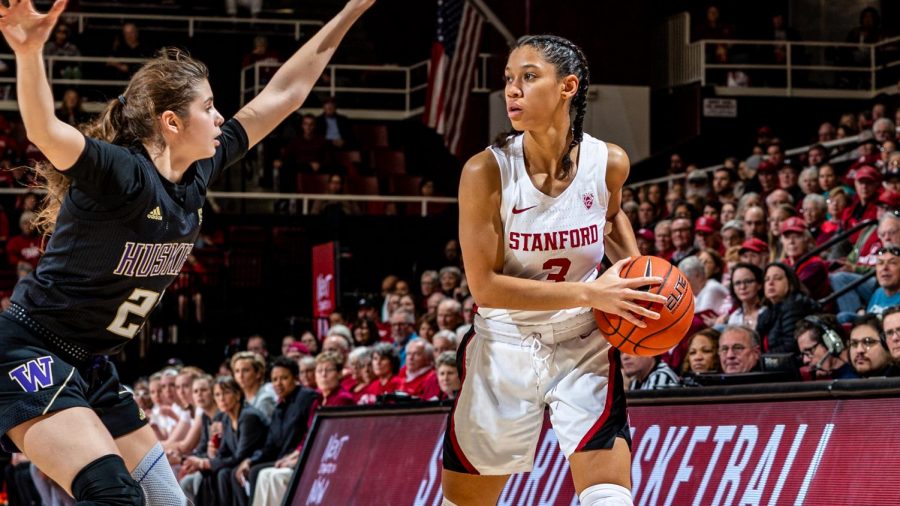The NCAA fails women: A symbol of the disparities in athletics
Recent outbursts during the NCAA Women’s Basketball Championship revealed the jarring disparities in the sport.
The 2021 NCAA Women’s Basketball Championship kicked off in March, hidden in the shadows of American media with its viewership a fraction of its male counterpart. But soon after the start of the championship, players publicized the laughable and appalling difference between the men’s and women’s facilities on social media, suddenly pushing the women’s championship into the public eye.
The majority of media coverage focused on the inequalities of the training facilities. The victorious Stanford basketball player, Hannah Jump, described the weight room (or lack thereof) arranged for the NCAA championship as “a rack of dumbbells that went up to about 25lbs, 3 yoga mats, and some bands,” while the men’s facilities took up an entire ballroom with more squat racks and exercise machines than could possibly be utilized. Jump summarized her outrage by asserting,“Just because we’re girls doesn’t mean we don’t lift heavy, too.”
Another disparity observed by the female players was the quality of meals provided by the NCAA. Jump indicated the importance of a well-balanced diet when playing at an elevated and elite level such as the NCAA, and believes that the supplied meals were not “enough for these athletes to fuel themselves” properly. In contrast, the men were catered an abundance of nourishing and balanced meals which offered sufficient nutrients to sustain and enrich their athletic performance.
Along with these disappointing differences, the Stanford Women’s Basketball team’s morale was significantly assaulted by other unnecessary and unfair policies instituted by the NCAA. The players were confined to the hotel floor to adhere to coronavirus safety precautions, only allowed to venture outside for strictly transportational walks to and from the gym. Contrastly, the men’s facilities included a safe and vast outside area, while the women did not have access to anything of the sort. Jump described this restrictive detention as “unimaginable” and detrimental to her and her teammates’ mental health.
This was nowhere near the first time Hannah Jump experienced gender inequality while playing basketball. While at Stanford, Jump noticed the vast disparity of television coverage between the men’s and women’s teams, which in turn awards more marketing and publicity to the men’s team, despite the women’s team’s significantly higher rank and success rate.
Additionally, Jump talked of the considerable differences between the women’s and men’s NBA, and how the substantial pay gap repels her from joining the league. She illustrates this worry by asking, “if I want to play in the league, is that something I can do as a full-time job or to support my family?” This worry is not shared by male NBA players, as the annual average salary is around $7 million according to Fox Business.
This disparity separating genders does not only occur in elite levels of women’s basketball. From the conception of Hannah Jump’s basketball participation starting in elementary school, male peers have told her to play with the girls, that challenging the boys was not what she was “supposed to do.” Societal stereotypes seep into young minds, discouraging girls to play basketball due to pressure from others and themselves.
Does maturing in a non-coed setting prevent this discouragement? Catherine Debenham, a Castilleja basketball all-star and veteran, believes spending her developmental years at an all-girls school supported and cultivated her love for basketball more than a co-ed school could. She described the safe and non-judgmental environment Castilleja Middle School fostered, and how she “never felt embarrassed about [her] lack of skill regarding basketball.”
Debenham speculates her attitude around basketball would have changed if she had not enrolled in an all-girls school, as she says, “being in a co-ed environment would have made more people self-conscious and worried about how they looked while playing basketball, instead of how they felt.”
Jump also mentions her assumption that female-centered environments are not compatible with the toxic comparison between the gendered teams, which is yet another advantage of all-girls schools. Mary Jo Pruitt, Castilleja’s beloved Director of Athletics, concurs that Castilleja benefits from the absence of boys due to the lack of male intimidation or judgment, giving athletes the freedom to fail.
Pruitt also called attention to a gender disparity in sports not widely addressed: the lack of women in sports leadership. She explains that of the 13 teams in Castilleja’s league, only 2 have female athletic directors. Pruitt asserts that incorporating more powerful women in sports management positions could change the societal attitude towards gender inclusion in athletics.
Jac Heler, the indispensable basketball coach at Castilleja, believes that women’s sports could thrive with increased amounts of promotion and marketing. She points out the untapped potential of women’s college basketball, as the viewership of the NCAA championship rose greatly only after players gained fame on social media and self-marketed their teams. Heler also hopes to apply this strategy to build involvement in high school basketball, by “inviting the community in” to sports games and effectively advocating for Castilleja’s teams.
Although the disparities illustrated by the NCAA Women’s Basketball Championship were deeply disappointing, the increased awareness cultivates a widespread search for long-term solutions. The Stanford women’s basketball team is a perfect example of successfully overcoming demoralizing obstacles, while simultaneously striving for change. Before Stanford’s last game of the season with a NCAA championship at stake, Hannah Jump remembers her coach’s last sentiment: “Let’s go win a national championship and then use our platform to speak out.” Soon after, Stanford won the NCAA championship, beating out 64 teams for the top title.

Ella Holsinger '23 is the Editor of News for Counterpoint. Her favorite boba shop is Pop Tea Bar, and she loves pretzel goldfish. In her free time, she...


